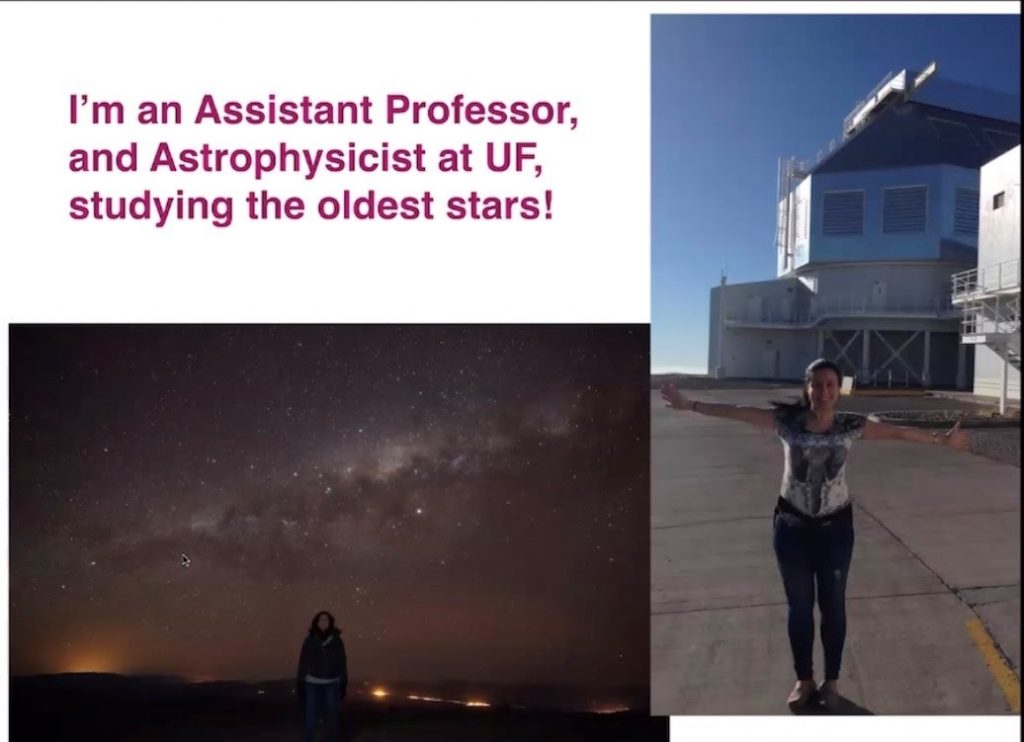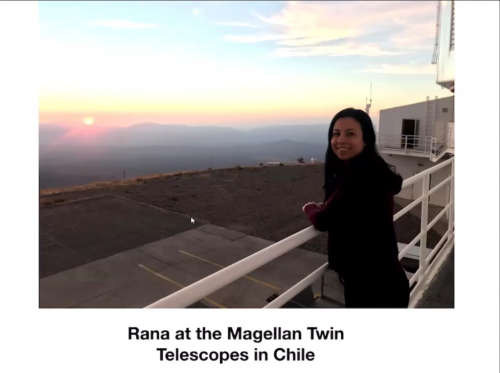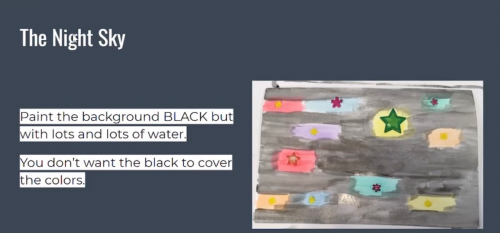“How are telescopes used to measure the light in stars?”
 Members of the West Palm Beach Chapter of the GEMS (Girls Excelling in Math and Science) club eagerly asked this question and more during a visit from University of Florida assistant professor and astrophysicist Rana Ezzeddine on November 10. The virtual “Galactic Getaway” was organized as part of a collaboration between the GEMS club and the UF Thompson Earth Systems Institute’s Scientist in Every Florida School Program (SEFS).
Members of the West Palm Beach Chapter of the GEMS (Girls Excelling in Math and Science) club eagerly asked this question and more during a visit from University of Florida assistant professor and astrophysicist Rana Ezzeddine on November 10. The virtual “Galactic Getaway” was organized as part of a collaboration between the GEMS club and the UF Thompson Earth Systems Institute’s Scientist in Every Florida School Program (SEFS).
Each month, the local GEMS club hosts monthly virtual sessions about the exciting world of math, science, engineering and technology to expose third through eighth-grade girls to possible STEM careers. While the SEFS team typically places working scientists in traditional K-12 public school classrooms, the collaboration with the GEMS club seemed like a good fit.
“One of the goals of SEFS is to provide access to scientist role models for students so they see themselves as scientists,” said Stephanie Killingsworth, K-12 education and outreach coordinator for SEFS. “Research shows girls start losing interest in science earlier than boys, so connecting them with strong female scientists is in line with our mission.”
During the virtual visit, Ezzeddine shared stories about her fascinating experiences studying ancient stars. She was eager to share her knowledge about the massive, expanding dark body that we call space.
As the curious students first logged on to Zoom, Ezzeddine explained to them that as a “galactic archeologist,” she studies the fossil record to uncover the history of our universe. While her scientific research spreads over a variety of topics related to stellar astrophysics, Ezzeddine primarily examines the chemical properties and signatures of stars to decipher the observational evidence of star formation, the creation of stellar populations, and the scientific events that led to the current elements of our galaxy.
 Ezzeddine shared how she uses massive telescopes to observe, analyze and model the atmosphere of stars. The instruments at the 6.5-meter Magellan telescope in the Atacama Desert in Chile allow scientists to switch quickly from one optical lens to another to view different objects in the sky. For example, using this very telescope, Ezzeddine was able to detect the iron content in old stars.
Ezzeddine shared how she uses massive telescopes to observe, analyze and model the atmosphere of stars. The instruments at the 6.5-meter Magellan telescope in the Atacama Desert in Chile allow scientists to switch quickly from one optical lens to another to view different objects in the sky. For example, using this very telescope, Ezzeddine was able to detect the iron content in old stars.
Just as the GEMS club is helping to inspire young girls, one of Ezzeddine’s biggest influencers was Annie Jump Cannon, the female astronomer who created the stellar classification, or the system astronomers use to characterize stars. Ezzeddine said Cannon is a great example for girls who have big ambitions in STEM.
Though Ezzeddine spends a lot of time doing lab work, traveling and meeting new people are some of her favorite parts of the job. She shared a photo montage of all the amazing places she has traveled to for work. Ezzeddine has visited Germany to see the Potsdam Great Refractor Telescope; traveled to Kyoto, Japan to speak to the Cosmic Front documentary series about detecting iron in the oldest stars; and attended the Moon Shots event at the Massachusetts Institute of Technology Museum.
In one travel photo, Ezzeddine pointed at the light pollution in the back of the photo and used it as a teaching moment. She explained that light pollution is caused by an abundance of artificial light that blocks out the natural light from the night sky. Light pollution makes the job of astrophysicists more difficult because overbearing lights from homes and cities disrupt the sky’s ecosystem. So, Ezzeddine stressed to the students that they should turn off their lights when they are not using them.
 After Ezzeddine finished her presentation and answered student questions, the group completed an arts and crafts activity. The students used stickers, construction paper and paint to make their own “Night Sky,” based on what they learned.
After Ezzeddine finished her presentation and answered student questions, the group completed an arts and crafts activity. The students used stickers, construction paper and paint to make their own “Night Sky,” based on what they learned.
This Galactic Getaway was a success as students excitedly spoke about Ezzeddine’s presentation while painting their own solar systems. One student added that “Rana has a fun job!” And at the end of the presentation, some students exclaimed that there were anxiously awaiting the next GEMS virtual meetup.
The next GEMS virtual session “Marvelous Music,” will take place on Dec. 29. For questions and more information about the event, please email nrocha@sfsca.org or visit the GEMS’ website at https://www.sfsciencecenter.org/gems.
To request a scientist visit like this one to your classroom, visit the following link: Request a Scientist